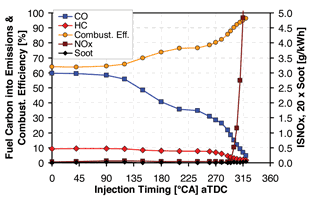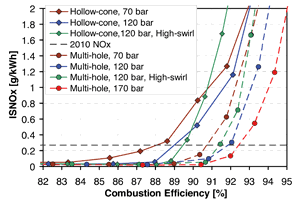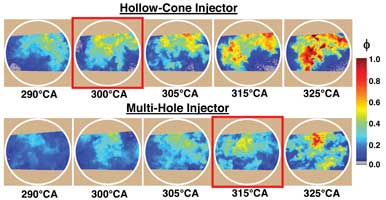
 |
 |
|||||
|
|||||
| Home | Research | About Us | Working with the CRF | Employment | News & Publications | People | Workshops & Databases | |||||
|
Printer-friendly Version
Home > View Article
Improving low-load combustion in HCCI engines  Figure 1. The effect of injection-timing retard on emissions and combustion efficiency for an idle fueling of φ = 0.12, hollow-cone injector, 120 bar injection pressure. Note that 0°CA is taken to be TDC of the intake stroke. Figure 1. The effect of injection-timing retard on emissions and combustion efficiency for an idle fueling of φ = 0.12, hollow-cone injector, 120 bar injection pressure. Note that 0°CA is taken to be TDC of the intake stroke.Homogeneous charge compression ignition (HCCI) is an alternative piston-engine combustion process that can provide both high efficiency and very low emissions of nitric oxides (NOX) and particulates. Several technical hurdles must be overcome, however, before this promising technology becomes viable. One of the most important hurdles is to improve combustion efficiency at low loads and reduce the associated emissions of carbon monoxide (CO) and unburned hydrocarbons (HC). Previous work (see CRF News March/April 2003) has shown that this problem occurs because combustion temperatures become so low with the very dilute fuel/air mixtures used for low-load HCCI (0.1 ≤ φ ≤ 0.2) that combustion does not go to completion before being quenched by the expansion stroke. This previous work also showed that stratifying the fuel/air mixture could improve low-load combustion efficiency by concentrating the fuel in the central part of the combustion chamber, so the mixture is locally less dilute. However, the amount of stratification allowable is limited because eventually the concentration of fuel in the richest regions increases to the point that combustion temperatures are sufficient to produce NOX emissions. In this previous work, combustion efficiency was increased from 51% for a well-mixed charge to 78% at the NOX limit. Although this is a substantial improvement, it is still an unacceptably low combustion efficiency.  Figure 2. Tradeoff between combustion-efficiency and NOX emissions for various injectors, injection pressures and swirl, φ = 0.12. Figure 2. Tradeoff between combustion-efficiency and NOX emissions for various injectors, injection pressures and swirl, φ = 0.12.To address this problem, CRF researchers Wontae Hwang, John Dec, and Magnus Sjöberg conducted an investigation of various fuel-stratification techniques to determine which parameters are effective for improving the combustion-efficiency/NOX tradeoff. Performance and emissions measurements were made in an all-metal engine, and planar laser-induced fluorescence (PLIF) measurements of the fuel distributions were made in a matching optically accessible engine. Parameters examined included the type of fuel injector, the injection pressure, and the amount of in-cylinder air swirl. All data were acquired at a low-load condition corresponding to an idle fueling rate. The fuel was iso-octane, which has been shown to be a good surrogate for gasoline. The required stratification was accomplished by decreasing the mixing time by using a gasoline-type direct fuel injector and progressively delaying the start of injection from early in the intake stroke until well up the compression stroke. An example of the changes in combustion efficiency and emissions with increasing stratification is shown in Figure 1. As can be seen, for a well-mixed charge (early injection timing), combustion efficiency is low and CO and HC emissions are high. However, as the fuel/air charge becomes progressively stratified with delayed injection, the CO and HC emissions fall substantially with a commensurate increase in combustion efficiency. This trend continues even for very late injection timings, but beginning at about 300°CA (for this case), NOX emissions begin to rise rapidly. With this hollow-cone spray injector, using 120 bar injection pressure, a combustion efficiency of 89% could be achieved at the US-2010 NOX emission standard, as show in Figure 2. Although this efficiency represents a substantial improvement from the 2003 data, resulting mainly from a wider-angle hollow-cone spray, even higher efficiencies are desirable. The results in Figure 2 also show that the multi-hole injector further improved the combustion-efficiency/NOX tradeoff, increasing combustion efficiency at the US-2010 NOX limit to 91.7% for the same 120 bar injection pressure. For both injectors, the NOX-limited combustion efficiency improved with increased injection pressure, reaching a value of about 92.5% for the multi-hole injector with 170 bar injection pressure.  Figure 3. Fuel/air equivalence ratio (φ) images derived from a fuel PLIF image. Figure 3a is uncorrected and Figure 3b is corrected for the temperature variation associated with fuel stratification. Figure 3c shows the corresponding temperature field. Figure 3. Fuel/air equivalence ratio (φ) images derived from a fuel PLIF image. Figure 3a is uncorrected and Figure 3b is corrected for the temperature variation associated with fuel stratification. Figure 3c shows the corresponding temperature field.To better understand the differences in the mixture formation for the various mixture-formation parameters, an improved quantitative fuel-PLIF imaging technique was developed and applied. Typically, equivalence-ratio (φ) images of fuel distributions are produced by simply applying a calibration to PLIF images obtained using a fluorescent tracer in the fuel. This method, however, neglects the effect of temperature variations associated with the non-uniform fuel distribution. These variations occur because regions of higher fuel concentration experience greater evaporative cooling and reduced compression heating (due to the increased specific heat when more fuel is present). To overcome this problem, the temperature sensitivity of the PLIF signal was mapped out at engine conditions, and an iterative technique was developed to correct the PLIF images for these thermal effects. As illustrated by the difference between the images in Figures 3a and 3b, this correction has a significant impact on the apparent fuel distribution. The correction technique also provides the corresponding temperature map, as shown in Figure 3c.  Figure 4. Series of φ—maps of the fuel distribution as injection delayed for the hollow-cone and multi-hole injectors with 120 bar injection pressure. The red box around the 300°CA (hollow-cone) and 315°CA (multi-hole) images indicates that they correspond to the knee in the NOX curves in Figures 1 and 2. The images were acquired at 365°CA in the mid-plane of the combustion chamber. Figure 4. Series of φ—maps of the fuel distribution as injection delayed for the hollow-cone and multi-hole injectors with 120 bar injection pressure. The red box around the 300°CA (hollow-cone) and 315°CA (multi-hole) images indicates that they correspond to the knee in the NOX curves in Figures 1 and 2. The images were acquired at 365°CA in the mid-plane of the combustion chamber.Figure 4 presents sequences of temperature-corrected quantitative "φ-map" images for the hollow-cone and multi-hole injectors. The sequences show how the delayed injection affects the fuel distributions present at the time of combustion (365°CA). For both injectors, the amount of mixture stratification increases progressively with a delayed start of injection. However, the mixing rate is faster with the multi-hole injector because it produces a more uniform mixture than the hollow-cone injector for any given injection timing. As a result, injection can be delayed until 315CA with the multi-hole injector while still maintaining NOX emissions well below US 2010 standards, whereas the hollow-cone injector can only be delayed until 300CA, as indicated by the images outlined in red in the figure. Examination of these images shows a maximum φ of 0.6 to 0.7, in agreement with the onset of the sharp rise in NOX emissions observed under fired conditions in the metal engine. For both image sequences, later injection timings produced higher equivalence ratios, in agreement with the large increase in NOX emissions (Figures 1 and 2). These results show that appropriate adjustment of the parameters controlling fuel/air mixing can significantly improve the combustion-efficiency/NOX tradeoff for low-load HCCI, providing combustion efficiencies up to 92.5%. In general, faster mixing rates combined with later injection timings were found to give better performance. This finding suggests that development of fuel-injection systems with even faster mixing could further improve combustion efficiency and provide more robust operation at low-loads. Article taken from the Sept/Oct CRF News Volume 30 Number 5 (PDF - 3905K) |